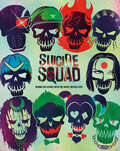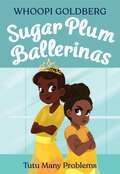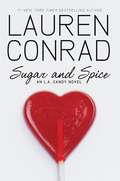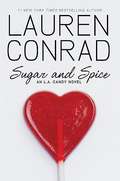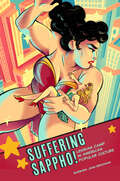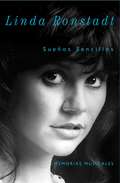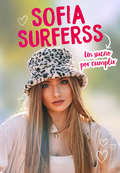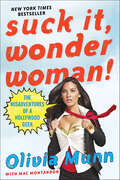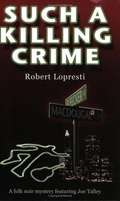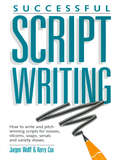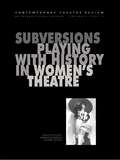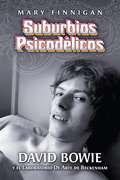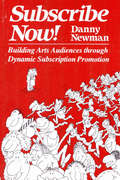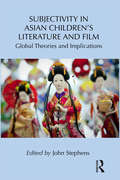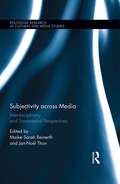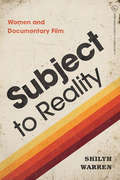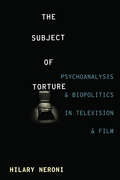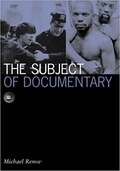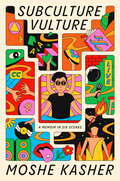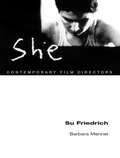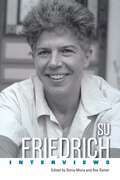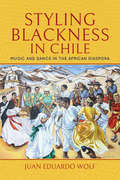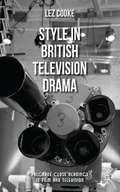- Table View
- List View
Suicide Squad: Behind the Scenes with the Worst Heroes Ever
by Signe BergstromIt feels good to be bad...Assemble a team of the world’s most dangerous, incarcerated super-villains, provide them with the most powerful arsenal at the government’s disposal, and send them off on a mission to defeat an enigmatic, insuperable entity. U.S. intelligence officer Amanda Waller has determined only a secretly convened group of disparate, despicable individuals with next to nothing to lose will do. However, once they realize they weren’t picked to succeed but chosen for their patent culpability when they inevitably fail, will the Suicide Squad resolve to die trying, or decide it’s every man for himself?
Suggestopedia and Language
by W. Jane BancroftFirst published in 1999. Routledge is an imprint of Taylor & Francis, an informa company.
Sugar Plum Ballerinas: Tutu Many Problems (Sugar Plum Ballerinas)
by Whoopi Goldberg Deborah UnderwoodThe fourth book of the award-winning and bestselling Sugar Plum Ballerinas series by Whoopi Goldberg—now featuring brand-new illustrations! At the Nutcracker School of Ballet in Harlem, young dancers learn to chassé, plié, and jeté with their Sugar Plum Sisters—but things don't always go to plan! As the girls encounter challenges both on and off stage, they'll need the support of their classmates to carry them through with aplomb. Terrel is always in charge, whether she's making lists for grocery shopping (her favorite hobby, AFTER ballet), keeping her brothers in line, or organizing father-daughter time in with her dad. Lately, though, her dad's been acting a little strange--wearing new clothes and way too much aftershave. Things get even weirder when he surprises Terrel with his new girlfriend during a night out at the ballet - a night that was supposed to be father-daughter time. What's more, his "date" brought her niece along. A niece who turns out to be Terrel's ballerina nemesis, Tiara Girl! With some Sugar Plum help, Terrel takes charge of breaking up her father's new relationship.
Sugar and Spice (L.A. Candy #3)
by Lauren ConradSugar and Spice ... Not everyone's nice. Fresh from being betrayed by one of her closest friends, new reality-television celebrity Jane Roberts has learned a few lessons. Most important: know who to trust. And in Hollywood, that list is short. Although the press is intent on creating a tabloid war between her and ex-friend/current-costar Madison Parker, Jane just wants to take control of her life. She's started by swearing off guys and the drama that comes with them. But when her high school sweetheart Caleb and her unrequited L. A. crush Braden show up, both acting sweeter than ever, Jane has a hard time remembering her no-boys rule. . . . Her best friend, Scarlett, has only one guy on her mind: her new boyfriend, Liam. The girl who once thought love was a four-letter word is now head over heels. The problem is, being on a hit reality show means hanging out with other guys on-camera, and Liam isn't too happy with pretending to play a bit part in her love life. Just when everything feels out of control, Jane makes a shocking discovery--one that changes everyone's definition of "reality" forever. In her deliciously entertaining novel, television star Lauren Conrad pulls back the curtain on young Hollywood and shows that sometimes the real drama is behind the scenes.
Sugar and Spice: An L.A. Candy Novel
by Lauren ConradSugar and Spice . . . Not everyone's nice. Fresh from being betrayed by one of her closest friends, new reality-television celebrity Jane Roberts has learned a few lessons. Most important: know who to trust. And in Hollywood, that list is short. Although the press is intent on creating a tabloid war between her and ex-friend/current-costar Madison Parker, Jane just wants to take control of her life. She's started by swearing off guys and the drama that comes with them. But when her high school sweetheart Caleb and her unrequited L.A. crush Braden show up, both acting sweeter than ever, Jane has a hard time remembering her no-boys rule. . . . Her best friend, Scarlett, has only one guy on her mind: her new boyfriend, Liam. The girl who once thought love was a four-letter word is now head over heels. The problem is, being on a hit reality show means hanging out with other guys on-camera, and Liam isn't too happy with pretending to play a bit part in her love life. Just when everything feels out of control, Jane makes a shocking discovery-one that changes everyone's definition of "reality" forever. In her deliciously entertaining novel, television star Lauren Conrad pulls back the curtain on young Hollywood and shows that sometimes the real drama is behind the scenes.
Suffering Sappho!: Lesbian Camp in American Popular Culture
by Barbara Jane BrickmanAn ever-expanding and panicked Wonder Woman lurches through a city skyline begging Steve to stop her. A twisted queen of sorority row crashes her convertible trying to escape her queer shame. A suave butch emcee introduces the sequined and feathered stars of the era’s most celebrated drag revue. For an unsettled and retrenching postwar America, these startling figures betrayed the failure of promised consensus and appeasing conformity. They could also be cruel, painful, and disciplinary jokes. It turns out that an obsession with managing gender and female sexuality after the war would hardly contain them. On the contrary, it spread their campy manifestations throughout mainstream culture. Offering the first major consideration of lesbian camp in American popular culture, Suffering Sappho! traces a larger-than-life lesbian menace across midcentury media forms to propose five prototypical queer icons—the sicko, the monster, the spinster, the Amazon, and the rebel. On the pages of comics and sensational pulp fiction and the dramas of television and drive-in movies, Barbara Jane Brickman discovers evidence not just of campy sexual deviants but of troubling female performers, whose failures could be epic but whose subversive potential could inspire. Supplemental images of interest related to this title: George and Lomas; Connie Minerva; Cat On Hot Tin; and Beulah and Oriole.
Sueños Sencillos: Memorias musicales
by Linda RonstadtEn esta memoria, la cantante icónica Linda Ronstadt entreteje una historia cautivante de sus orígenes en Tucson, Arizona, y su ascenso a la fama en la escena musical del sur de California en los años 60 y 70.Al rastrear la cronología de su extraordinaria vida, Linda Ronstadt, una artista cuya carrera ha abarcado cinco décadas e incluye una amplia gama de estilos musicales, se entreteje una historia cautivante de sus orígenes en Tucson, Arizona, y su ascenso a la fama en la escena musical del sur de California de los años sesenta y setenta. Nacida en una familia de músicos, la infancia de Linda estuvo llena de música que iba desde Gilbert y Sullivan a la música popular mexicana, al jazz y a la ópera. Su curiosidad artística fue precoz, y ella y sus hermanos comenzaron a tocar su música a cualquiera que quisiera escucharlos. Ahora, en este libro de memorias maravillosamente escritas, Ronstadt cuenta la historia de su viaje musical amplio y completamente único. Ronstadt llegó a Los Ángeles cuando el movimiento folk-rock estaba empezando a florecer, preparando así el escenario para el desarrollo del country-rock. Como parte del círculo de artistas afines que tocaron en el famoso club Troubadour en West Hollywood, ella contribuyó a definir el estilo musical que dominó la música mexicana y estadounidense en la década de 1970. Una de sus primeras bandas de respaldo pasó a convertirse en los Eagles, y Linda se volvió en la artista femenina más exitosa de la década. En Sueños Sencillos, Ronstadt revela el viaje ecléctico y fascinante que condujo a su éxito duradero, incluyendo algunas historias detrás de muchas de sus queridas canciones. Y describe todo con una voz tan hermosa como la que cantó "Heart Like a Wheel": de un modo nostálgico, elegante y auténtico.
Sueños Sencillos: Memorias musicales
by Linda RonstadtAl rastrear la cronología de su extraordinaria vida, Linda Ronstadt, una artista cuya carrera ha abarcado cinco décadas e incluye una amplia gama de estilos musicales, se entreteje una historia cautivante de sus orígenes en Tucson, Arizona, y su ascenso a la fama en la escena musical del sur de California de los años sesenta y setenta. Nacida en una familia de músicos, la infancia de Linda estuvo llena de música que iba desde Gilbert y Sullivan a la música popular mexicana, al jazz y a la ópera. Su curiosidad artística fue precoz, y ella y sus hermanos comenzaron a tocar su música a cualquiera que quisiera escucharlos. Ahora, en este libro de memorias maravillosamente escritas, Ronstadt cuenta la historia de su viaje musical amplio y completamente único. Ronstadt llegó a Los Ángeles cuando el movimiento folk-rock estaba empezando a florecer, preparando así el escenario para el desarrollo del country-rock. Como parte del círculo de artistas afines que tocaron en el famoso club Troubadour en West Hollywood, ella contribuyó a definir el estilo musical que dominó la música mexicana y estadounidense en la década de 1970. Una de sus primeras bandas de respaldo pasó a convertirse en los Eagles, y Linda se volvió en la artista femenina más exitosa de la década. En Sueños Sencillos, Ronstadt revela el viaje ecléctico y fascinante que condujo a su éxito duradero, incluyendo algunas historias detrás de muchas de sus queridas canciones. Y describe todo con una voz tan hermosa como la que cantó "Heart Like a Wheel": de un modo nostálgico, elegante y auténtico.
Un sueño por cumplir
by Sofía Surferss¡Una nueva aventura de Sofía Surferss! La carrera de Sofía Surferss no para de crecer. Tiene un montón de proyectos chulísimos, como grabar un anuncio superguay en Madrid. Además, su madre y su hermana también se vienen. ¡Viaje de chicas! Sin embargo, entre las muchas aventuras que les esperan en la gran ciudad, se esconde algún que otro contratiempo... ¡¿pero por qué tiene tanta mala suerte?! ¿Conseguirá Sofía salir airosa de todos sus accidentes y llegar a tiempo al rodaje? No te pierdas una nueva aventura de Sofía Surferss
Suck It, Wonder Woman!: The Misadventures of a Hollywood Geek
by Olivia Munn Mac MontandonSuck It, Wonder Woman! brings Olivia Munn's unique humor, incredible wit, and lightning-fast costume changes to a world that needs more scrapbooking, sea monkeys, and for the love of God, a freakin' hoverboard!In this hilarious collection you'll find essays like "thought's About My First Agent's Girlfriend's Vagina," wherein Olivia skewers what it's like to live in Hollywood. In "Sex: What You Can Do to Help Yourself Have More of It," she frankly gets down to the business of getting it on, including advice on how to appropriately wrap it and bag it. In "What to Do When the Robots Invade (Yes, When!)," Olivia offers valuable information on . . . what to do when the robots invade! And just when you thought she couldn't get any more geeky, she can. This book also includes such handy treasures as a timeline of great moments in Geek history, a flip book, an unofficial FAQ section, and a nifty (read: smokin') foldout poster.
Such A Killing Crime
by Robert LoprestiIf you're not old enough to have lived through the folk scare, listening to folk music and reading this book will give you a sense of the time period and Greenwich Village. Joe Tally becomes involved in a murder of an up and coming folksinger.
Successful Scriptwriting: How to write and pitch winning scripts for movies, sitcoms, soaps, serials and v ariety shows
by Jurgen Wolff Kerry CoxSUCCESSFUL SCRIPTWRITINGLet's start with "The End." The credits roll - we see "Screenplay by ..." and there's your name. The show's a hit! It's Emmy/Oscar night, and you're seated up front. The nominations are revealed; your name is called. Your acceptance speech is memorable, an inspiration to the new writers "breaking in." Variety says your "future looks very bright." Hooray for Hollywood! But how did you get here?With talent, determination, and the help of this comprehensive guide, you'll have the wherewithal to move your dream from your mind onto the page and to succeed in this fiercely competitive, highly selective field.Starting with a basic course in scriptwriting, Jurgen Wolff and Kerry Cox teach you the fundamental skills of writing the feature film script, from original idea to finished screenplay. Then you'll learn how to apply your new-found skills to every type of television and film script: movies-of-the week, episodic television, situation comedies and soap operas.You'll also find helpful insight from the greats in the business, like Colin Higgins (Harold and Maude, Foul Play, 9 to 5), Larry Gelbart (Oh, God!, Tootsie, "M*A*S*H"), William Bickley ("Perfect Strangers," "Happy Days"), and Steven Bochco ("Doogie Howser, M.D.," "L.A. Law"). And you'll find answers to these essential questions:What fundamental skills and essential ingredients do I need to write a feature film script?By what criteria do producers and studios evaluate scripts or ideas presented to them?When should I write an outline or a treatment for my script, and what are the formats?How do I go about protecting my work?Is there a cut-and-dried technique for pitching my ideas?Every part of this book reflects the needs and realities of today's TV and film industry, providing you with insight as well as practical knowledge. With this book as your guide, you can start at the beginning and follow a well-defined path to successful scriptwriting.
Subversions
by Erika Block Gabriele Griffin Julie WilkinsonFirst Published in 1998. Routledge is an imprint of Taylor & Francis, an informa company.
Suburbios Psicodélicos: David Bowie y el Laboratorio de Arte de Beckenham
by Mary Finnigan Alexia PolaskyEl año crucial de David Bowie antes de su ascenso a la fama: por su amiga, amante y casera. Suburbios psicodélicos: David Bowie y el Laboratorio de Arte de Beckenham David Bowie tenía 22 años y todavía vivía con sus padres en el sudeste de Londres cuando, por casualidad, conoció a Mary Finnigan mientras visitaba a sus vecinos de arriba en la cercana Beckenham. Aun un talento no reconocido que frecuentaba clubes populares de Londres en busca desesperada de actuaciones remuneradas, ni siquiera podía soñar con un futuro como un fenómeno del rock a nivel global. La vida comenzó a tomar interesantes giros después de que se mudó con Mary y sus dos hijos en la primavera de 1969. Con un pequeño grupo de pioneros psicodélicos lanzaron el Laboratorio de Arte de Beckenham en un pub local y organizaron un festival de música gratuito en el parque de la ciudad. Ese verano Space Oddity, su primer éxito, llegó a los ránkings y se convirtió en la canción del primer alunizaje. Finalmente estaba camino al estrellato. Se han escrito millones de palabras sobre la vida de Bowie, pero sus primeros días como compositor e intérprete se han visto envueltos en rumores. Aquí está la historia completa de su año crucial en Beckenham, escrita por su amiga, amante y casera; una de las primeras personas que lo alentó y apoyó.
Subscribe Now!
by Danny Newman"Buy it, borrow it, steal it, but get your hands on it! If you follow Danny's advice on how to sell tickets, you won't have an unsold seat in the house all season long!"--Ralph Black, American Symphony League
Subjectivity in Asian Children's Literature and Film: Global Theories and Implications (Children's Literature and Culture)
by John StephensWinner of the Children’s Literature Association Honor Book Award This volume establishes a dialogue between East and West in children’s literature scholarship. In all cultures, children’s literature shows a concern to depict identity and individual development, so that character and theme pivot on questions of agency and the circumstances that frame an individual’s decisions and capacities to make choices and act upon them. Such issues of selfhood fall under the heading subjectivity. Attention to the representation of subjectivity in literature enables us to consider how values are formed and changed, how emotions are cultivated, and how maturation is experienced. Because subjectivities emerge in social contexts, they vary from place to place. This book brings together essays by scholars from several Asian countries — Japan, India, Pakistan, Korea, Vietnam, Taiwan, Australia, Thailand, and The Philippines — to address subjectivities in fiction and film within frameworks that include social change, multiculturalism, post-colonialism, globalization, and glocalization. Few scholars of western children's literature have a ready understanding of what subjectivity entails in children’s literature and film from Asian countries, especially where Buddhist or Confucian thought remains influential. This volume will impact scholarship and pedagogy both within the countries represented and in countries with established traditions in teaching and research, offering a major contribution to the flow of ideas between different academic and educational cultures.
Subjectivity across Media: Interdisciplinary and Transmedial Perspectives (Routledge Research in Cultural and Media Studies)
by Jan-Noël Thon Maike Sarah ReinerthMedia in general and narrative media in particular have the potential to represent not only a variety of both possible and actual worlds but also the perception and consciousness of characters in these worlds. Hence, media can be understood as "qualia machines," as technologies that allow for the production of subjective experiences within the affordances and limitations posed by the conventions of their specific mediality. This edited collection examines the transmedial as well as the medium-specific strategies employed by the verbal representations characteristic for literary texts, the verbal-pictorial representations characteristic for comics, the audiovisual representations characteristic for films, and the interactive representations characteristic for video games. Combining theoretical perspectives from analytic philosophy, cognitive theory, and narratology with approaches from phenomenology, psychosemiotics, and social semiotics, the contributions collected in this volume provide a state-of-the-art map of current research on a wide variety of ways in which subjectivity can be represented across conventionally distinct media.
Subject to Reality: Women and Documentary Film (Women & Film History International)
by Shilyh WarrenRevolutionary thinking around gender and race merged with new film technologies to usher in a wave of women's documentaries in the 1970s. Driven by the various promises of second-wave feminism, activist filmmakers believed authentic stories about women would bring more people into an imminent revolution. Yet their films soon faded into obscurity. Shilyh Warren reopens this understudied period and links it to a neglected era of women's filmmaking that took place from 1920 to 1940, another key period of thinking around documentary, race, and gender. Drawing women’s cultural expression during these two explosive times into conversation, Warren reconsiders key debates about subjectivity, feminism, realism, and documentary and their lasting epistemological and material consequences for film and feminist studies. She also excavates the lost ethnographic history of women's documentary filmmaking in the earlier era and explores the political and aesthetic legacy of these films in more explicitly feminist periods like the Seventies. Filled with challenging insights and new close readings, Subject to Reality sheds light on a profound and unexamined history of feminist documentaries while revealing their influence on the filmmakers of today.
The Subject of Torture: Psychoanalysis and Biopolitics in Television and Film
by Hilary NeroniConsidering representations of torture in such television series as 24, Alias, and Homeland; the documentaries Taxi to the Dark Side (2007), Ghosts of Abu Ghraib (2007), and Standard Operating Procedure (2008); and "torture porn" feature films from the Saw and Hostel series, Hilary Neroni unites aesthetic and theoretical analysis to provide a unique portal into theorizing biopower and its relation to the desiring subject. Her work ultimately showcases film and television studies' singular ability to expose and potentially disable the fantasies that sustain torture and the regimes that deploy it.
Subject Of Documentary (Visible Evidence Ser. #Vol. 16)
by Michael RenovThe documentary, a genre as old as cinema itself, has traditionally aspired to objectivity. Whether making ethnographic, propagandistic, or educational films, documentarians have pointed the camera outward, drawing as little attention to themselves as possible. In recent decades, however, a new kind of documentary has emerged in which the filmmaker has become the subject of the work. Whether chronicling family history, sexual identity, or a personal or social world, this new generation of nonfiction filmmakers has defiantly embraced autobiography. In The Subject of Documentary, Michael Renov focuses on how documentary filmmaking has become an important means for both examining and constructing selfhood. By looking at key figures in documentary filmmaking as well as noncanonical video art and avant-garde artists, Renov broadens the definition of what counts as documentary, and explores the intersection of the personal and political, considering how memory can create a way into asking troubling questions about identity, oppression, and resiliency. Offering historical context for the explosion of personal nonfiction filmmaking in the 1980s and 1990s, Renov analyzes films in which the subjectivity of the filmmaker is expressly defined in relation to political struggle or historical trauma, from Haskell Wexler's Medium Cool to Jonas Mekas's Lost, Lost, Lost. And, looking beyond the traditional documentary, Renov contemplates such nontraditional modes of autobiographical practice as the essay film, the video confession, and the personal Web page.Unique in its attention to diverse expressions of personal nonfiction filmmaking, The Subject of Documentary forges a new understanding of the heightened role and function of subjectivity in contemporary documentary practice.Michael Renov is professor of critical studies at the USC School of Cinema-Television. He is the editor of Theorizing Documentary and the coeditor of Resolutions: Contemporary Video Practices (Minnesota, 1996) and Collecting Visible Evidence (Minnesota, 1999).
Subculture Vulture: A Memoir in Six Scenes
by Moshe KasherA &“hilarious&” (Dax Shepard), &“surprisingly emotional trip&” (The Chainsmokers) through deep American subcultures ranging from Burning Man to Alcoholics Anonymous, by the writer and comedian Moshe Kasher &“Part history lesson, part standup set and, often, part love letter . . . Kasher&’s ability to blend humor with homework works almost too well.&”—The New York TimesAfter bottoming out, being institutionalized, and getting sober all by the tender age of fifteen, Moshe Kasher found himself asking: &“What&’s next?&” Over the ensuing decades, he discovered the answer: a lot.There was his time as a boy-king of Alcoholics Anonymous, a kind of pubescent proselytizer for other teens getting and staying sober. He was a rave promoter turned DJ turned sober ecstasy dealer in San Francisco&’s techno warehouse party scene of the 1990s. For fifteen years he worked as a psychedelic security guard at Burning Man, fishing hippies out of hidden chambers they&’d constructed to try to sneak into the event. As a child of deaf parents, Kasher became deeply immersed in deaf culture and sign language interpretation, translating everything from end-of-life care to horny deaf clients&’ attempts to hire sex workers. He reconnects and tries to make peace with his ultra-Hasidic Jewish upbringing after the death of his father before finally settling into the comedy scene where he now makes his living.Each of these scenes gets a gonzo historiographical rundown before Kasher enters the narrative and tells the story of the lives he has spent careening from one to the next. A razor-sharp, gut-wrenchingly funny, and surprisingly moving tour of some of the most wildly distinct subcultures a person can experience, Subculture Vulture deftly weaves together memoir and propulsive cultural history. It&’s a story of finding your people, over and over again, in different settings, and of knowing without a doubt that wherever you are is where you&’re supposed to be.
Su Friedrich (Contemporary Film Directors)
by Barbara MennelAuteurism expanded With acclaimed films like Sink or Swim and The Odds of Recovery, Su Friedrich’s body of work stands at the forefront of avant-garde and Queer cinema. Barbara Mennel examines the career of an experimental auteur whose merger of technical innovation and political critique connects with both cinephiles and activists. Friedrich’s integration of cinematic experimentation with lesbian advocacy serves as a beginning rather than an end point of analysis. With that in mind, Mennel provides an essential overview of the filmmaker’s oeuvre while highlighting the defining characteristics of her artistic and political signature. She also situates Friedrich within the cultural, political, and historical contexts that both shape the films and are shaped by them. Finally, Mennel expands our notion of auteurism to include directors who engage in collaborative and creative processes rooted in communities.
Su Friedrich: Interviews (Conversations with Filmmakers Series)
by Sonia Misra and Rox SamerSu Friedrich (b. 1954) has been described as an autobiographical filmmaker, an experimental filmmaker, a documentary filmmaker, an independent filmmaker, a feminist filmmaker, and a lesbian filmmaker—labels that she sprucely dodges, insisting time and again she is, quite simply, a filmmaker. Nevertheless, the influences of the experimental film culture and of the feminist and lesbian political ethos out of which she emerged resonate across her films to the present day. Su Friedrich: Interviews is the first volume dedicated exclusively to Friedrich and her work. The interviews collected here highlight the historical, theoretical, political, and economic dimensions through which Friedrich’s films gain their unique and defiantly ambiguous identity. The collection seeks to give a comprehensive view of Friedrich’s diverse body of work, the conditions in which her films were made, and how they have circulated and become understood within different contexts. The volume contains fifteen interviews—two previously unpublished—along with three autobiographical writings by Friedrich. Included are canonical early interviews, but a special focus is given to interviews that address her less-studied film production in the twenty-first century. Echoing across these various pieces is Friedrich’s charmingly sardonic and defiant personality, familiar from her films. Her occasional resistance to an interviewer’s line of questioning opens up other, unexpected lines of inquiry as it also provides insight into her distinct philosophy. The volume closes with a new interview conducted by the editors, which illuminates areas that remain latent or underdiscussed in other interviews, including Friedrich’s work as a film professor and projects that supplement Friedrich’s filmmaking, such as Edited By, an online historical resource dedicated to collecting information about and honoring the contributions of women film editors.
Styling Blackness in Chile: Music and Dance in the African Diaspora
by Juan Eduardo WolfChile had long forgotten about the existence of the country’s Black population when, in 2003, the music and dance called the tumbe carnaval appeared on the streets of the city of Arica. Featuring turbaned dancers accompanied by a lively rhythm played on hide-head drums, the tumbe resonated with cosmopolitan images of what the African Diaspora looks like, and so helped bring attention to a community seeking legal recognition from the Chilean government which denied its existence. Tumbe carnaval, however, was not the only type of music and dance that Afro-Chileans have participated in and identified with over the years. In Styling Blackness in Chile, Juan Eduardo Wolf explores the multiple ways that Black individuals in Arica have performed music and dance to frame their Blackness in relationship to other groups of performers—a process he calls styling. Combining ethnography and semiotic analysis, Wolf illustrates how styling Blackness as Criollo, Moreno, and Indígena through genres like the baile de tierra, morenos de paso, and caporales simultaneously offered individuals alternative ways of identifying and contributed to the invisibility of Afro-descendants in Chilean society. While the styling of the tumbe as Afro-descendant helped make Chile’s Black community visible once again, Wolf also notes that its success raises issues of representation as more people begin to perform the genre in ways that resonate less with local cultural memory and Afro-Chilean activists’ goals. At a moment when Chile’s government continues to discuss whether to recognize the Afro-Chilean population and Chilean society struggles to come to terms with an increase in Latin American Afro-descendant immigrants, Wolf’s book raises awareness of Blackness in Chile and the variety of Black music-dance throughout the African Diaspora, while also providing tools that ethnomusicologists and other scholars of expressive culture can use to study the role of music-dance in other cultural contexts.
Style in British Television Drama (Palgrave Close Readings in Film and Television)
by Lez CookeThis pioneering book provides detailed analysis of scenes from nine British television dramas produced between 1954 and 2001. Taking dinner table scenes as a recurring motif, the study analyses changes in televisual style with reference to production practices, technology, aesthetic preferences, and social and institutional change.
